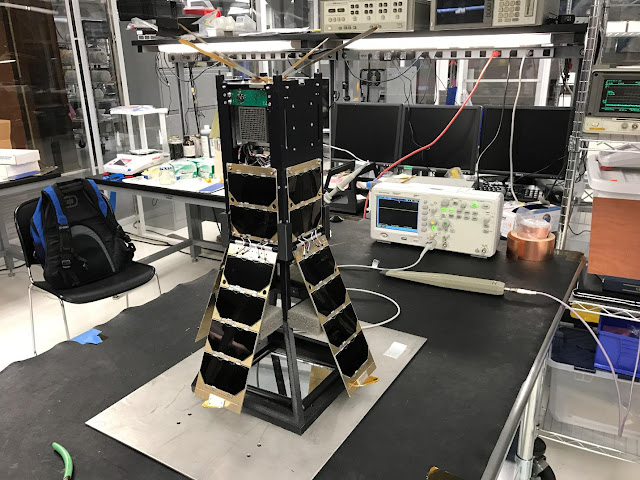A university-built small satellite known as the Cosmic X-Ray Background NanoSat-2 (CXBN-2) is being prepared for its upcoming ambitious science mission. The spacecraft – scheduled for launch into space on March 19 – is expected to deliver crucial data that could advance our knowledge about the cosmic X-ray background (CXB).
Led by Morehead State University (MSU), the CXBN-2 project addresses fundamental science questions regarding the structure, origin and evolution of the universe. To answer these questions, the satellite will conduct high precision measurements of the CXB.
“The goal of the CXBN-2 mission is to increase the precision of measurements of the CXB in the 30 to 50 keV range to a precision of almost five percent, thereby constraining models that attempt to explain the relative contribution of proposed sources and lending insight into the underlying physics of the early universe,” Benjamin Malphrus, CXBN-2 Principal Investigator at MSU told Astrowatch.net.
CXBN-2 is a small two-unit CubeSat that will rely on its two Cadmium Zinc Telluride (CZT) detectors to achieve its scientific goals. Together with the satellite’s improved array configuration, these instruments will be able to carry out high precision measurements of the CXB.
 |
| CXBN-2 mission logo. Image Credit: MSU |
“With the novel CZT detector aboard CXBN-2 and an improved array configuration, a new, high precision measurement is possible,” Malphrus noted.
The CZT detectors were developed by Redlen Technologies, a leading manufacturer of high-resolution semiconductor radiation detectors. The company has produced extremely uniform crystalline structure CZT material though the manufacturing process known as the Traveling Heater Method (THM). This allows uniformity in the semiconductor material so that charge is evenly distributed, allowing greater energy resolution and detection by bleeding off impurities.
The CZT detectors form the REDLEN M1770 CZT Array, an imaging module onboard the CXBN-2 CubeSat. This module is a 256-pixel radiation detector that is configured in a 16x16 matrix with a 2.46 mm pixel pitch. It consists of a 2x2 array of 64-pixel CZT detectors with thicknesses of five mm and bonded to a common cathode plate.
“Though originally intended for the detection of X-ray and gamma-ray photons while operating at room temperature and for applications in medical physics and security imaging, we found that the CZT detectors possessed the desired energy resolution and photon efficiency over the energy range of interest for the mission.” Thomas Pannuti, CXBN-2 Science Principal Investigator at MSU told Astrowatch.net.
 |
| CXBN-2 Flight Unit in the Morehead State University Space Science Center Spacecraft Integration and Assembly Facility. Photo Credit: MSU |
With a mass of about 5.7 lbs. (2.6 kilograms), the CXBN-2 CubeSat has dimensions of 3.93 x 3.93 x 7.87 inches (10 x 10 x 20 centimeters) and is fitted with four deployable solar arrays capable of generating up to 15 W of power. The satellite incorporates a power distribution and handling system known as PMD, a command and data handling system (C&DH) based on a Cortex Arm processor, and an innovative attitude determination and control system (ADACS) developed at MSU.
In comparison with the first CXBN mission which was sent into space in September 2012, the CXBN-2 CubeSat has two 256 pixel arrays instead of one. Moreover, it features an innovative 3-D printed Tungsten collimator, a series of improvements to the spacecraft bus, and an innovative conops characterized by a free flying minimally spinning spacecraft.
In this configuration, the CXBN-2 satellite has the potential to advance our understanding about the diffuse X-ray background in particular and the temporal evolution of supermassive black holes at the centers of galaxies in general. Malphrus and his colleagues are convinced that their CubeSat will provide measurements of the CXB with high precision, thus constraining models that address the relative contribution of the proposed dominant emitting source population (namely heavily absorbed active galactic nuclei).
“Such a high precision measurement of the CXB will provide insight into the underlying physics of the early universe and provide a window on the most energetic objects in the distant universe,” Malphrus explained.
CXBN-2 is currently in the final phase of preparations for its March 19 liftoff from Space Launch Complex 41 at Cape Canaveral Air Force Station in Florida. The last pre-launch activities include finalizing the ground support software and continuing characterization of the engineering model CZT arrays. The satellite’s flight and engineering models were completed in the Fall of 2016 and passed flight qualification testing. The flight unit was delivered to the launch integrator, Nanoracks, in December 2016 and was subsequently shipped to the Kennedy Space Center in Florida.
The CXBN-2 CubeSat will be launched atop an Atlas V rocket, piggybacking on the seventh Cygnus spacecraft mission to the International Space Station (ISS). Besides Cygnus and CXBN-2, a fleet of other satellites, mainly technology demonstrators, will be also sent into orbit on this mission.
Although MSU has already sent five smallsats into space, the CXBN-2 CubeSat seems to be the university’s most significant science mission so far.
“We are entering a new era of significant science being supported by CubeSats and Morehead State is at the forefront of this enterprise. The opportunity to participate in astrophysics research facilitated by the CubeSat platform as well as to train our students in space systems engineering and observational astrophysics through live space missions like CXBN-2 is invaluable to our research program, our academic programs and to our students,” Pannuti concluded.
Quelle: ASTRO WATCH


